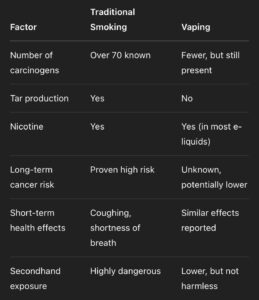Does Vaping Cause Cancer? Unpacking the Truth

Vaping has become a hugely popular substitute for regular cigarette smoking within the past ten years. Vape pens and e-cigarettes, which are promoted as a safer and “cleaner” alternative, have grown popular among smokers and a trend among younger people. However, one question remains prominent despite the increase in vaping: “does vaping cause cancer?”
Let’s examine the evidence, dispel myths, and comprehend what the science currently has to say regarding vaping and its connection to cancer.
#What is Vaping?
Inhaling aerosol—also known as vapor—produced by an electronic cigarette or other similar device is known as vaping. When a liquid, also known as vape juice or e-liquid, is heated, this aerosol is produced. The majority of e-liquids have:
– Nicotine
– Propylene glycol or vegetable glycerin (or both)
– Flavorings
– Other chemicals
Electronic cigarettes don’t burn tobacco like regular cigarettes do. Tar and many of the harmful compounds present in combustible tobacco products are therefore not produced by them. However, that does not imply that they are risk-free.
#Understanding Cancer Risk
Carcinogens are compounds known to cause cancer, and exposure to them frequently results in changes to DNA that cause cancer. We have known for decades that smoking is a major cause of cancer, especially lung cancer, but it also causes cancers of the throat, mouth, esophagus, and bladder.
Scientists are now wondering if the compounds in vape aerosol induce similar DNA damage or other carcinogenic effects, even though vaping avoids some of the pollutants associated with burning.
#What the Science Says (So Far)
According to recent studies, vaping may increase the risk of developing cancer.
1. Exposure to Fewer Carcinogens—But Not None
Comparing e-cigarette vapor to cigarette smoke, studies have shown that the former contains substantially fewer harmful compounds. That does not imply, however, that the vapor from e-cigarettes is devoid of dangerous chemicals. Studies have revealed the existence of:
– Formaldehyde (a known carcinogen)
– Acetaldehyde
– Acrolein
– Tobacco-specific nitrosamines (TSNAs)
– Heavy metals like nickel, tin, and lead
These substances originate from the metal parts of the apparatus or are byproducts of the heating process.
2. Nicotine Is Addictive—And May Promote Tumor Growth
Nicotine can indirectly cause cancer even if it is not a known carcinogen. Although this is still being studied, some evidence indicates that nicotine may encourage the growth of pre-existing tumors by promoting angiogenesis, or the creation of new blood vessels.
3. Cell and Animal Studies Raise Concerns
Mice’s lung and bladder cells have shown DNA damage as a result of e-cigarette vapor exposure in laboratory experiments. According to other research, vaping exposure causes oxidative stress and inflammation, two cancer risk factors. These are early results, nevertheless, and do not represent a human cancer risk that has been established.
4. Long-Term Human Data Is Limited
Usually, it takes years or even decades for cancer to grow. There is just insufficient long-term human data to definitively identify whether vaping causes cancer because it is a relatively new practice, having only become popular in the early 2010s.
#Comparing Risks: Vaping vs. Smoking

Though it’s a low standard, it’s clear from this comparison that *vaping is probably less dangerous than smoking*. “Less harmful” is not synonymous with “safe.”

#Youth Vaping and Cancer Risk
The increase in teen and young adult vaping is one of the biggest public health issues. Until about age 25, the brain is still developing, and nicotine use during this period can cause long-term behavioral and cognitive problems.
More concerning is the theory that vapers may have a higher chance of subsequently starting to smoke cigarettes—a phenomenon referred to as the “gateway effect.” Their risk of developing cancer in the future may rise sharply if this occurs.
#Regulatory Responses
Globally, governments and health institutions have begun to address the ambiguities around vaping:
– The “FDA” has issued warnings and banned certain flavored e-cigarettes to reduce youth appeal.
– The “World Health Organization (WHO)” has urged caution, stating that vaping is not harmless and should be regulated.
– Some countries, like “Australia” , have strict rules requiring prescriptions to purchase nicotine vapes.
#The Bottom Line
So, “can vaping lead to cancer?” *We don’t know yet* is the most truthful response. However, here is what we do know:
– Vaping exposes users to “fewer carcinogens than smoking”, but not zero.
– Certain chemicals found in vape aerosol “are known to cause cancer” in animals or in lab tests.
– The long-term human data simply doesn’t exist yet because vaping is too new.
Vaping “may” lower your cancer risk if you currently smoke, but giving up both is still the best course of action.
“Starting to vape introduces unnecessary health risks,” including the possibility of developing cancer, if you don’t smoke, especially if you’re young.

#Final Thoughts
Vaping is not risk-free, and the cancer question is yet unanswered, even if it may be a useful tool for adult smokers looking to reduce harm. The safest course of action, as research continues to explore, is to stay away from all types of nicotine and substances that are breathed whenever feasible.
See a healthcare professional if you want to stop smoking or vaping. There are safer, more efficient ways to address your long-term health concerns, such as behavioral assistance, medicine, and patches.